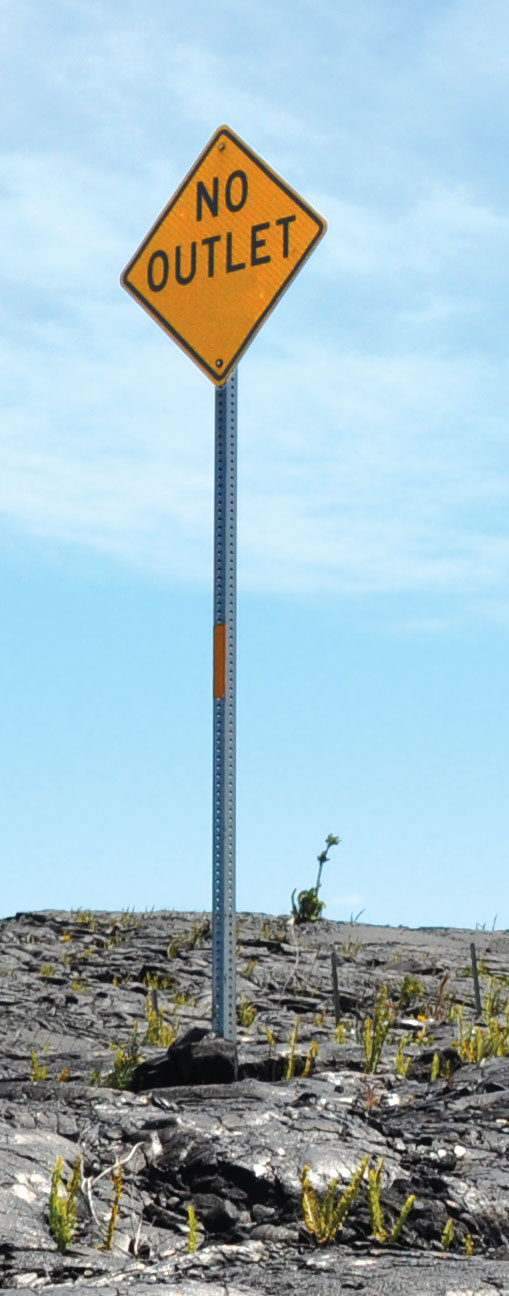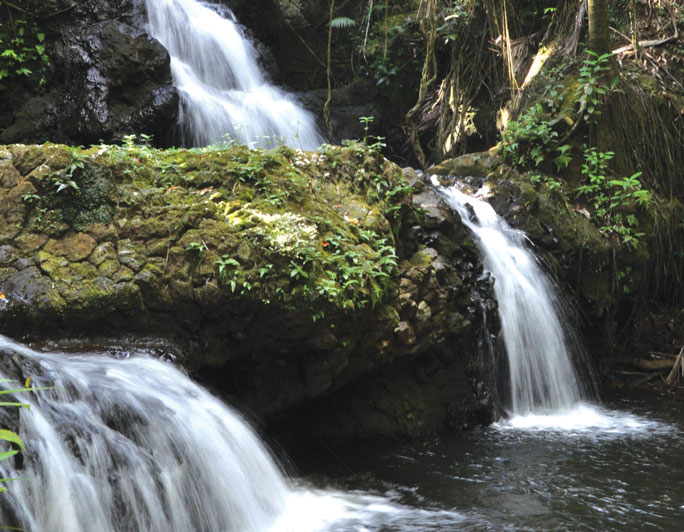A Study In Contrasts
Story and photos by Lois Whitney Bisquera
On the Big Island, diversity is everywhere. It vacillates between boiling and freezing, barren and lush, ancient and cutting-edge. It’s a sightseeing extravaganza, one which rewards the persistent with a fascinating tour de force.
FIRE AND ICE
At Hawaii Volcanoes National Park, rock melts into molten liquid as the contents of the earth’s core are pumped upward into plain view. Kilauea’s current eruption has been active since 1983, and Madame Pele, considered by Hawaiian practitioners to be the goddess of fire, has been busy. Red-hot rivers flow down the side of Kilauea to the edge of the sea, greeted by roiling waves. A hiss of smoke, and newly formed land hardens into rocky cliff ledges, still unstable shelves haphazardly erected over the Pacific. The water, stirred by heat and gases, is rocked by repeated implosions as underwater pillow lava explodes inwardly like a popped bubble gum bubble.
Night brings a profound appreciation for the intensity of color and heat accompanying the volcanic variety show. Up close, the fiery mass evokes an odd sense of reverence, as if one were in a church sanctuary. Visitors from around the globe gather in clusters, in awe of the raw, nascent earth.
Just a few scant miles away, a congregation of jacket-clad sightseers meditates quietly– this time on the night sky. The top of Mauna Kea is one of the best star- viewing locations in the world, and the faithful often brace frigid temperatures– and even snow and ice. Skiers and snowboarders take advantage of winter snowfall, while stargazers revel in the clear- albeit thin- air surrounding the dormant shield volcano.
Considered by Hawaiians to be the most sacred place in the island chain, Mauna Kea was once restricted to visits by priests who understood the mana, or spiritual essence of the mountain.
Today, tour companies provide toasty – thick coats and winter wear, and the white mountain acknowledges the presence of many whose journey isn’t complete without a trip to the top of the world. That’s right, forget Everest: Mauna Kea is THE tallest peak in the world, measured from its undersea base to its top.
THE BOLD AND THE BEAUTIFUL
A trek to the endless lava fields at Kalapana is often a sanctioned trail head for night-time lava viewing, it’s a humbling experience to simply walk out and stand on the barren lava field during the day. Between 1986 and 1989, lava flows overran numerous homes, roads, churches and other structures on their undeterred path to the sea. Yet new homes have risen from the ashes, and occupants proudly exist off-grid amongst the endless sworls of once-liquid rock.
Another virtual lava desert is found within the boundaries of the National Park, at the aptly-named Desolation Trail. Here, nearly nothing grows atop the cinders except for a few hardy ferns and ‘ohia lehua sprigs determined to make a go of it in shallow crevices that catch dew and raindrops.
Along the edges of the ash, giant tree ferns thrive in the mist. And across the island on its wet Eastern coast, raindrops and foliage converge in raging waterfalls and moist jungle lands. The transformation is stunning, especially following a heavy rain that can turn a meek trickle into a thundering cascade. Boiling Pots, Rainbow Falls, Akaka Falls, Umauma Falls… an array of waterfalls beckon one to view their beauty- from a safe distance.
BEAUTY AND THE BEAST
It’s okay, even recommended, to get up-close-and-personal with thou- sands of species of palms, flowering plants and trees, shrubs, vines and even the “cannonball tree” at the Hawaii Tropical Botanical Garden. Located along the scenic drive outside Hilo on the Old Mamalahoa Highway, the botanical garden is an eye-popping buffet of colors, scents, shapes– and endangered species.
The garden is replete with its own serene waterfalls, orchid garden, massive tiki carvings and shady sitting areas. The paved pathways allow wheelchair access to most areas, and a golf cart tour is available for a nominal fee. Blessed with some rain? Even better- the garden comes alive in the rain! Umbrellas gladly provided.
Just outside the garden’s sanctuary in the forests lining the scenic drive are pockets of the invasive species miconia, with its broad, dark leaves
that block sunlight and precipitation from native forests. The pesky plants from South and Central America were unwittingly introduced as a garden plant in 1961, but the now-noxious weeds grow up to 50 feet tall and threaten to harm watershed areas through erosion and by choking out native species. Removal programs partner with community groups and private landholders, yet the Big Island miconia infestations have managed to keep a strong foothold on the windward side.
ANCIENT CULTURE, MODERN INNOVATION
Many centuries before the arrival of pests like mosquitos and miconia, the indigenous people enjoyed a more pristine environment that they carefully protected through sustain- able practices. The traditional land-division system, the ahupua‘a, created pie-shaped pieces of land from mountain top to the sea. This provided people with opportunities to farm, fish, gather building materials and prepare for cultural practices and community gatherings without having a detrimental impact on the environment. The law of kapu also guided the taking of resources at certain times of the year, which allowed the land and sea to regenerate before human impact depleted the area.
Several accessible petroglyph viewing areas on the Big Island give visitors a glimpse of what was on the minds of these early Hawaiians, with ancient rock carvings depicting turtles, canoes and the sun, along with many other illustrative and artistic designs. The petroglyphs are a vivid reminder of- and link to- the past, conjuring visions of the artists tapping the smooth surfaces of the rocks without any metal tools, etching their mark in history. Countless petroglyphs were lost to development, but a number of clusters have been preserved and can be seen at Waikoloa Beach Resort behind the Kings’ Shops, at Mauna Lani Resort in a historic park, and at the Hawaii Volcanoes National Park on the Chain of Craters Road.
Back in Hilo, don’t miss the modern cultural storytelling at the University of Hawaii’s ‘Imiloa museum. This high-tech voyage to the past features interactive exploration of Hawaii’s seafaring canoe heritage, 3D shows at a full-dome planetarium and an award-winning native plant landscape. A virtual tour of one of Mauna Kea’s 13 observatories is another highlight, as are the hands-on displays about the cosmos and man’s innovative attempts to understand it.
